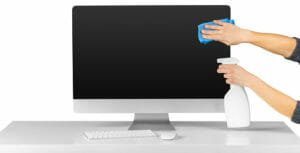Table of Contents
Do I need to clean my computer monitor? If so, how often and how should I clean it?
Computer monitors get dirt from accumulated dust particles, sneezing, water, and coffee spills. This dirt may have an insignificant effect on your monitor but might be a big deal in touchscreen monitors. The dirt may also clog some parts and cause fans problems when built up massively. You may fail to quickly notice the dirt and dust particles on the monitor unless it is a black screen.
Key Takeaways
- Turn off your monitor. It’s easier to see smudges and stuff on a black screen, so turning off your monitor makes it easier to see what you are doing
- Wipe your monitor with a microfiber cloth. Avoid using paper tower or old clothes.
- There are gentle cleaning fluids designed for monitors, but distilled water works well, too. It’s important you only use filtered or distilled water.
- When you are finished, allow the monitor to air dry and then you can turn your monitor on.
You should clean the PC monitor regularly and in a proper way. Read through to learn more on how to clean computer monitors.
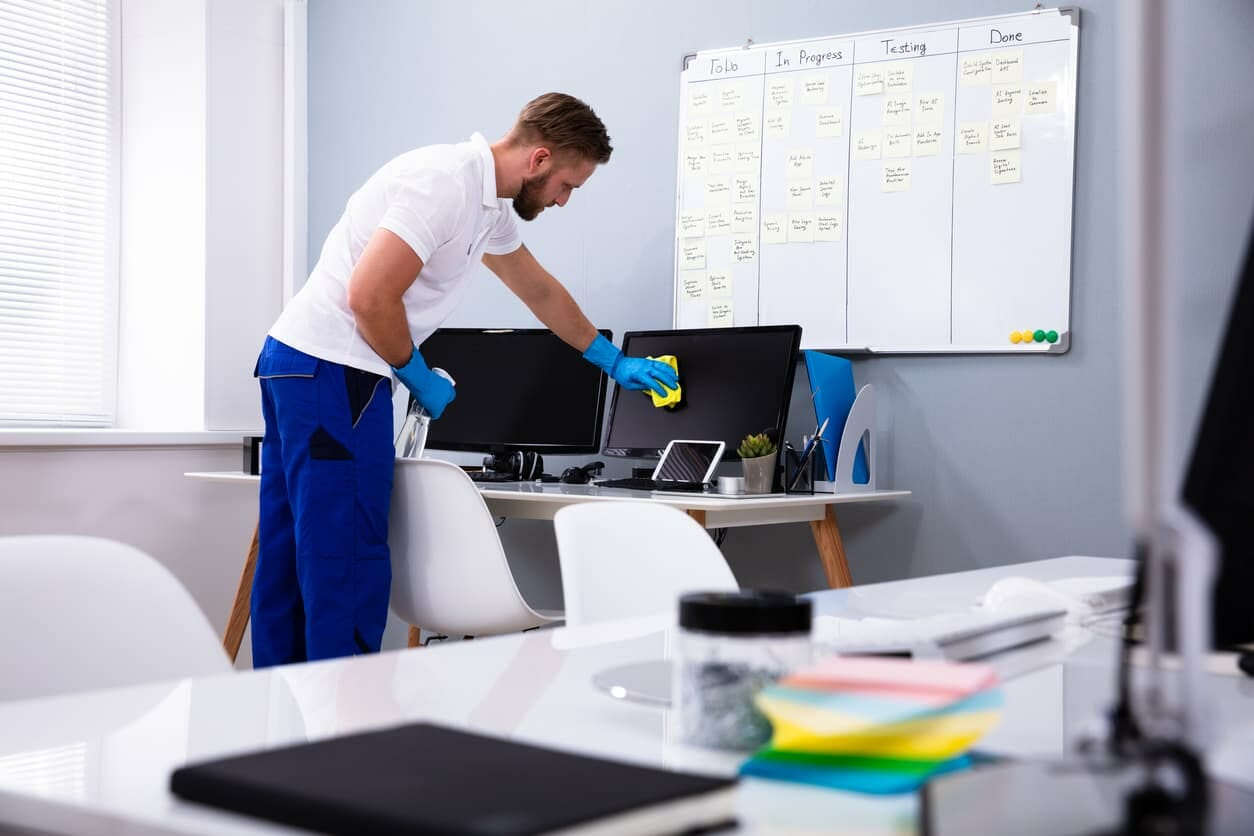
Does it Matter How You Clean Your Computer Monitor?
Yes, it matters a lot how you clean your computer monitor (see our guide for CRT monitors). Cleaning the monitor regularly is essential but can run the monitor into more problems when done wrong. First of all, the materials you use to clean the monitor matter most. Some chemicals, when used, may wear out coatings from the monitor.
Also, abrasive materials may cause scratches when used to wipe the monitor screen. The effort you apply while sipping delicate parts like the screen also matters. Carefully wipe these parts gently, with little effort; otherwise, you may break them.
What to Know Before Cleaning a Computer Screen
Computer screens are different and, therefore, require different cleaning approaches. For your safety and that of the monitor - see LED monitor maintainance - there are several measures you need to take into account when cleaning the computer monitor. Below is a list of what to do and what not to do while cleaning.
What to Do
Ensure you do the following for a safe and proper computer monitor cleaning process.
- Make sure to turn off the monitor before you start cleaning. This practice is of the essence when cleaning using any form of liquid. Failing to turn off the monitor may result in electric shock that may damage the monitor parts or harm you.
- Use a dry microfiber cloth to remove dust from the monitor's display surface (see plasma displays cleaning guide). You can also use a soft duster. This practice is vital to avoid creating scratches on the screen when dusting. Avoid using paper towels or any other abrasive material.
- Only use distilled water if needed. Avoid using hard water and regular cleaning supplies to wipe off the monitor's screen as it can damage the screen.
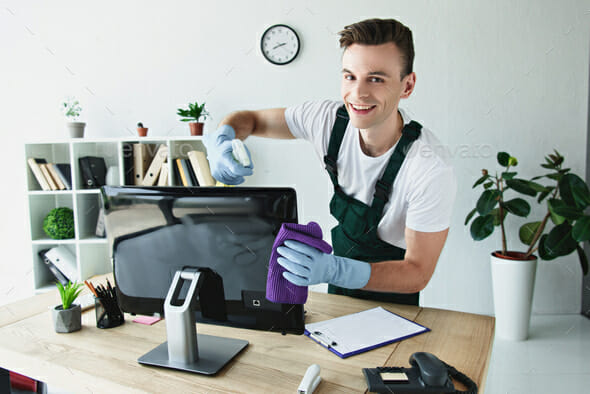
What Not to Do
You should, at all costs, avoid doing the practices listed below when cleaning your computer monitor.
- Do not use too much water. Use distilled water in small amounts only if the microfiber cloth leaves behind residual dirt particles or residues. Excess liquid on the computer screen may compromise it. The same will apply to any other cleaning fluid.
- Avoid using rubbing alcohol. Rubbing alcohol compromises the oleophobic layer of computer monitors, especially touchscreen monitors.
- Never apply the cleaning solvent to the monitor directly. Instead, apply it on a microfiber cloth. Direct application of the cleaning solvent may damage the monitor components.
- Do not clean the screen corners of the monitor with a moist cloth or paper towels. Wiping off moisture from the monitor corners may be difficult and damage the screen when left unwiped.
- Do not clean the computer monitor with corrosive or abrasive solutions. Corrosive solutions will compromise the screen surface integrity, while abrasive materials will scratch, leaving scratches and patches.
- Do not apply too much pressure while dusting the screen. A lot of pressure may break the delicate parts of the monitor.
Step by Step Procedure of Cleaning a Computer Screen
To clean the computer monitor safely, use the procedure given below.
Turn off your monitor and unplug it from the power source. A switched-off monitor quickly shows all dust and dirt than a switched-on screen. It is also safer to work on a monitor when it is off than when turned on. Switching the monitor off eliminates the risk of electrical shock that may build up due to static charges.
Give the monitor enough time to cool down before you start cleaning it.
Use a dry microfiber cloth to dust off the screen, removing all dust and debris. We recommend this type of cloth because it is soft enough to eliminate any scratches. An alternative to the microfiber cloth is a dry dusting cloth. You may need to confirm from the user manual the suitable cleaning alternative. A sponge dumbed with filtered or distilled water can work too.
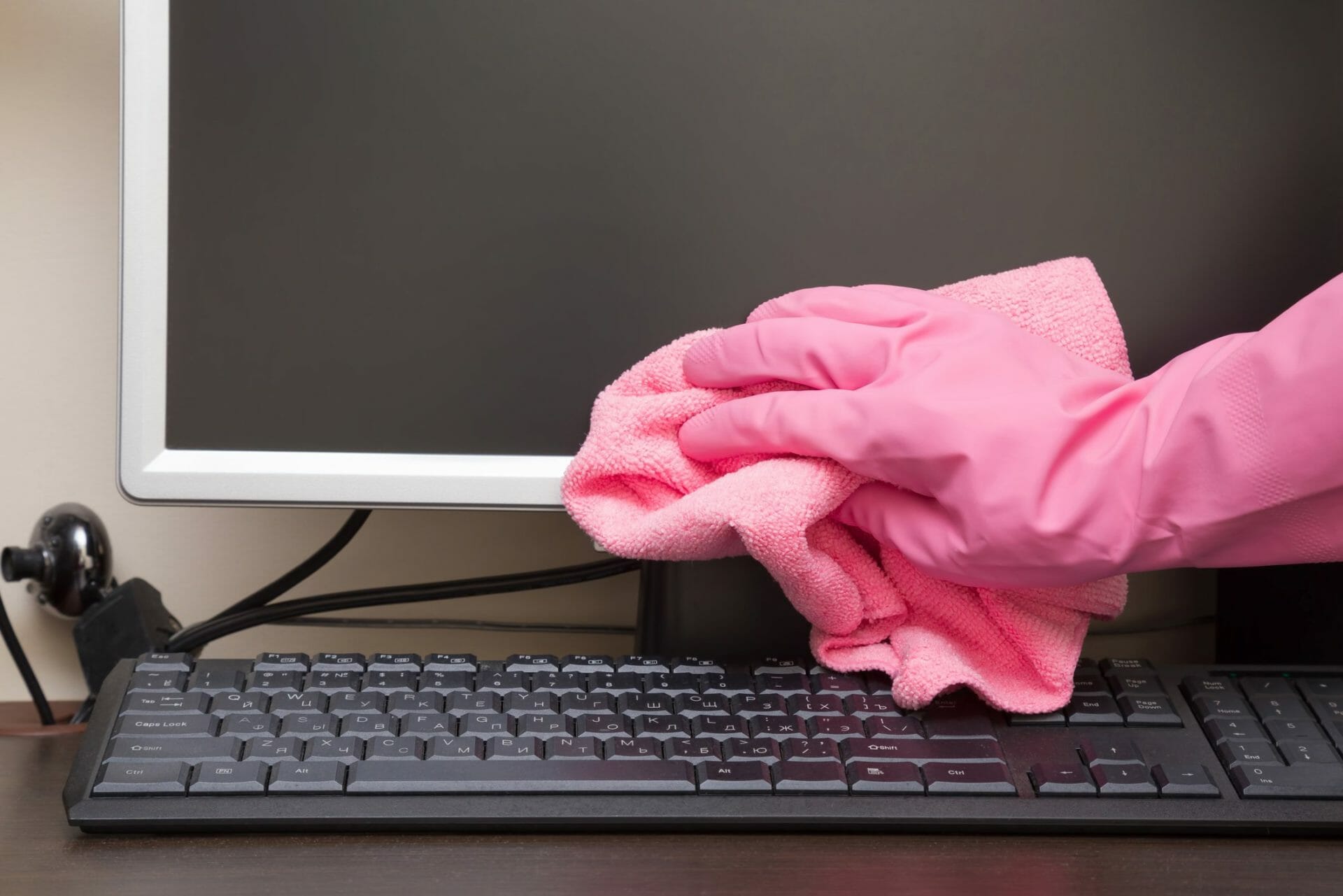
- Apply a minimal force when wiping the screen. Too much force may break the screen.
- Apply distilled water to the microfiber cloth if residues are left on the screen. You should not apply the distilled water directly to the screen as it might damage it. Also, apply a small amount of water, just enough to dampen the cloth. Corrosive solutions like acetone, alcohol, ammonia, and soapy solutions may compromise the monitor's screen when used, and you should, therefore, avoid using them.
- Use a solution of white vinegar and distilled water if the screen has stains that can't be wiped out with distilled water. Use a ratio of 1:1 to make the cleaning solution.
- When you're done with the screen, proceed to the outer frames. The frames are more robust than the screen, and you can press harder. However, you should use the same microfiber cloth and the distilled water solution to wipe off the dirt from the outer frames. Parts out of reach of the screen can allow for other non-abrasive cleaning solutions. Do not spray water directly to the casing as this can spray to the screen, damaging it in the process.
- Go on to clean the buttons, base, and finish by cleaning the back of your monitor.
- Unplug the power cords from the monitor and clean them too.
- Wipe the monitor with a dry cloth to dry off the moisture.
- Plugin the power cables and power on the monitor.
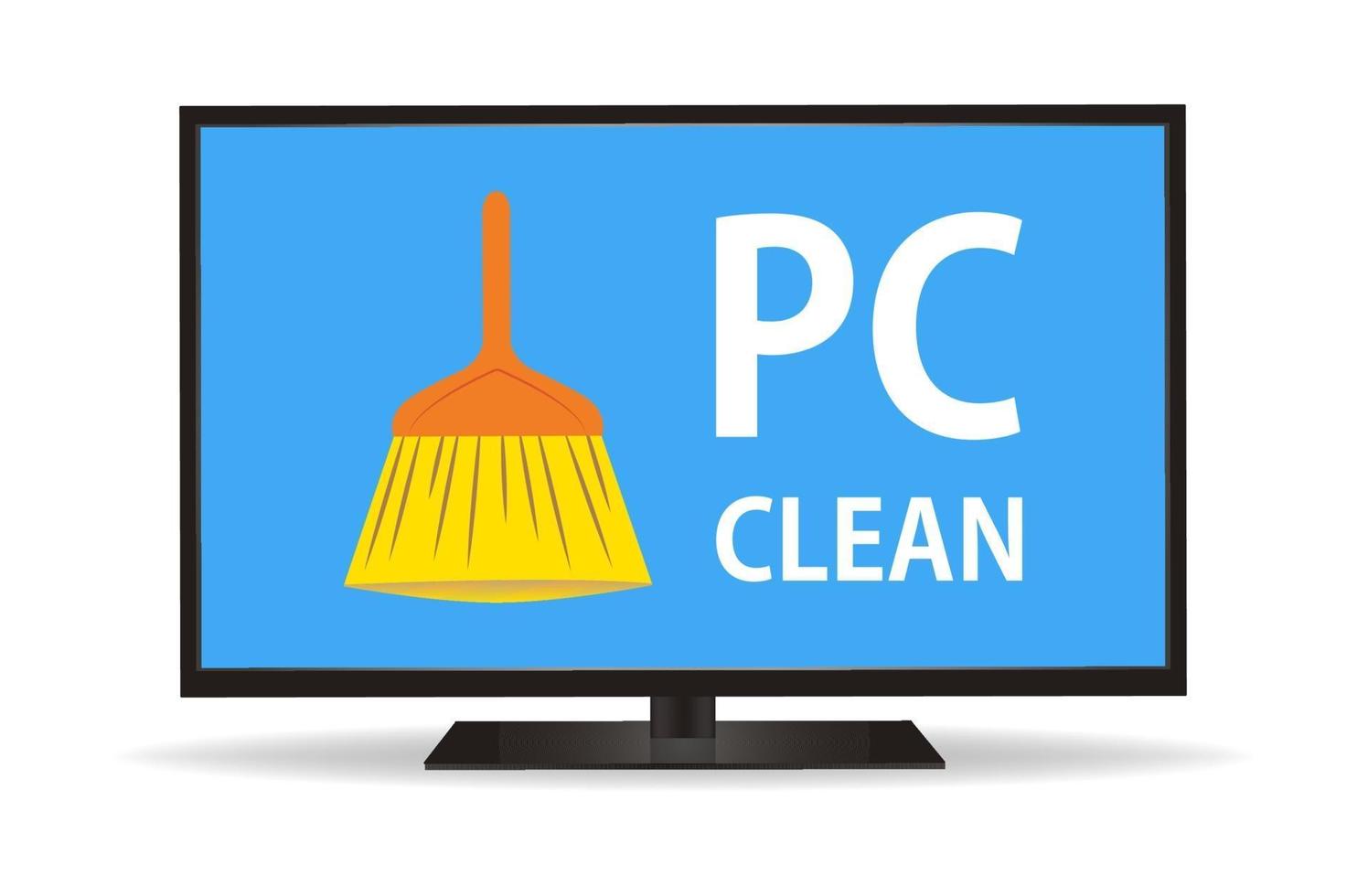
How Can I Eliminate Scratches From My Monitor’s Screen?
After cleaning the monitor, you might see some scratches on the screen. You can use the procedure given below to eliminate these scratches.
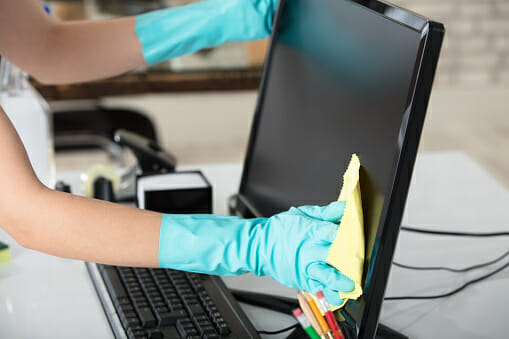
- Check your warranty coverage. If you're eligible for service or replacement for scratches, you can get it done for free from your manufacturer. Don't attempt to repair the scratches yourself, as it may void your warranty. Note that anti-glare screens are risky, and you may further damage the screen while attempting to fix the scratch.
- Use a scratch repair kit to remove the scratches. You'll readily find these kits in local computer stores, especially for an LCD screen. You can also get one from online marketplaces. Follow the guide as directed by the manufacturer to remove the scratches.
- You can also use petroleum jelly if you have a matte screen. This solution works best for minor scratches that need temporary solutions. Apply the jelly using a cotton swab on the scratch and use a microfiber cloth to rub the spot gently.
- You can also use non-gel toothpaste to cover the scratch. Use your fingertip to apply a small amount of toothpaste to the spot and gently wipe using the soft microfiber cloth. Wait for it to dry and then wipe off using a clean damp microfiber cloth.
- If possible, you can fix a screen protector to the monitor to prevent it from getting scratches in the future.
Screen Cleaning Products Exist if You Need These
The products for cleaning computer monitors are listed below.
- Microfiber cloth
- Sponge
- Distilled Water
- White Vinegar
- Windex
- AudioQuest Clean Screen
What Are the Necessary Measures to Keep Your Monitor Clean
The preventive measures to take to keep your touchscreen clean are listed below:
Wrap your touchscreen with a clean material when not using it for longer periods. This practice ensures that the static charge in the monitor does not attract dust particles.
Keep your surroundings clean and dust-free. Your monitor will draw dust particles due to its static charges. Ensure your surroundings are clean and free from dust particles to prevent this.
Avoid touching the monitor with dirty hands. Doing so will cause the dirt particles and debris in your hand to get attached to the touchscreen surface.
Keep water and other solutions off the monitor's screen. Spilling water on the touchscreen will compromise the screen surface, resulting in damage.
How Often to Clean a Computer Monitor?
The cleaning frequency necessary for a computer monitor depends on environmental factors and your usage habits. If the work area is particularly dusty, you frequently touch the screen or pick it up for moving, or are careless when eating and drinking around the monitor, clean it more often. For most users, a quick weekly cleaning will keep the monitor at its best.
How Do I Make My Own Monitor Cleaner?
Making this screen-cleaning spray couldn't be easier. Simply combine one part alcohol and one part distilled water in the spray bottle. Cap it, give it a quick shake, and it's ready for use. Variation: If you don't have isopropyl alcohol handy, you may substitute plain vinegar.
Final Word on How to Clean a Computer Monitor
Your computer monitor needs regular cleaning to keep it in good working condition. However, you need to be careful about cleaning the monitor; otherwise, you may break the delicate parts or further damage the monitor. Use a microfiber cloth whenever wiping the monitors and avoid spilling or directly spraying water or any other cleaning solution on the monitor. Lastly, consider your monitor's screen type before deciding on a cleaning solution.
FAQs
1. What should I clean my monitor screen with?
Start by removing any dust from the screen with a dry microfiber cloth. For fingerprints and smudges, spray 70% isopropyl alcohol onto a cloth, or use a pre-moistened alcohol wipe or a Clorox Disinfecting Wipe, to clean non-porous surfaces like the actual screen; do not use bleach.
2. What should you never use to clean a computer monitor?
Avoid using paper towels, old clothes, or napkins to wipe your computer monitor. Using abrasive pads, paper towel, or cleaning towel can scratch and damage the screen. It is recommended that you use a microfiber cloth instead of paper towel and similar abrasive stuff.
3. Can I use glass cleaner to clean my monitor?
Your monitor may not withstand multi purpose cleaners, window cleaners, household cleaners, aerosol sprays, solvents, ammonia, abrasives, or cleaners containing hydrogen peroxide to clean the screen.
4. Do alcohol wipes damage laptop?
Some manufacturers, including Dell and Lenovo, even say you can use a 50:50 mixture of isopropyl alcohol and water, if need be. Just avoid household cleaners with harsh chemicals like ammonia or alkaline on the screen.

